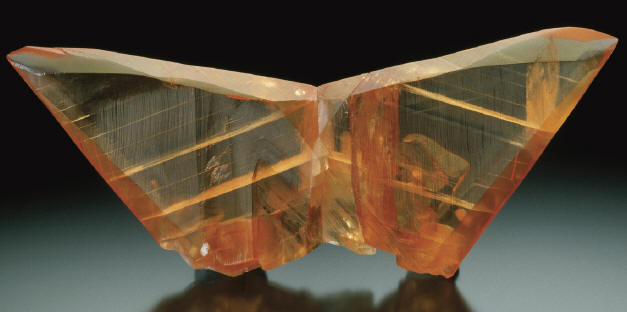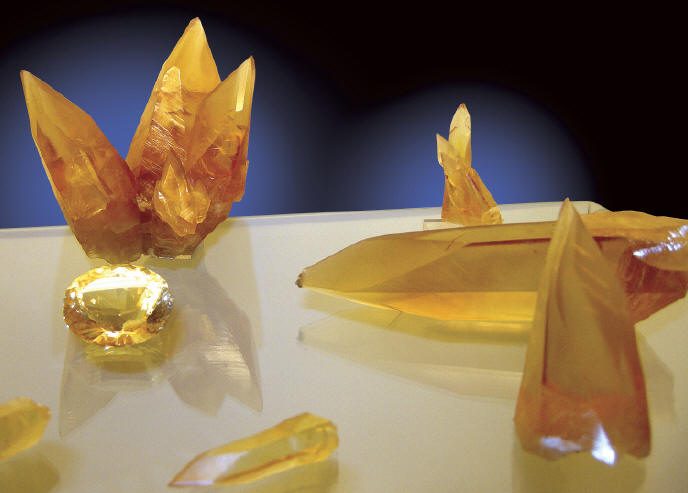When Kenneth was asked “Howin the world you did you manage to lower the specimen from the cavityentrance several meters up on thewall?”, he replied simply “When I reachedthe vertical wall I turned aroundand walked down the wall holding thespecimen in my arms and put it intothe back of the truck”. It is amazingwhat can be done with the adrenaline ofdiscovery and success!

Calcite specimen known as the “Rocket”, 10 cm high. P. Lyckberg specimen. C. Hager photo.

The biggest twin collected from the Butterfly Twin Pocket – 16.4 cm! P. Lyckberg specimen. J. Scovil photo.
Amazingly, the specimen placedon the truck bed survived not only thelong ride up out of the mine, but also thetemperature shock of coming from aheated underground mine straight outinto the -30°C polar climate of January,1989.

Group of crystals on magnetite ore from the Gem Pocket, field of view 8 cm. P. Lyckberg specimen and photo.
With the news of the fantastic specimen,I flew to Lappland to see this marvelouspocket, photographing it, and totry and recover additional specimens.
The pocket was more impressive thanthe first. Only sections of the walls hadlarge deep colored calcites, while otherparts had smaller light yellow crystals.
High humidity caused the lens of the camerato get foggy all the time but despitethis, some clear images were luckily capturedof this remarkable calcite pocket.
Crystals were completely clean inthe pocket and as fresh as having beenformed “yesterday”. Calcite is a veryfrgile and soluable mineral, and it is fortunatethese crystals survived such along geologic history. That the calcitessurvived blasting during the mining processis nearly miraculous. Major tunnelingwas only 2-3 meters from the pocket.
Some of the larger crystals found in thepocket had been broken off from matrixlong ago and recrystallized over the brokensurfaces. The largest butterfly twincollected reached over 16 cm!
During additional exploration aroundmain cavity a second smallerpocket was found at the back, left end ofthe main pocket. A couple of large calcitetwins were growing on the bottom of thispocket, one of which is now in the Museumof Natural History in Vienna.
As one can imagine, the discovery ofsuch a pocket started the rumor millturning, which in turn spurred otherminers to search for crystals. It also ledto intense traffic of visitors, dealers, andcollectors not only from Sweden, butalso Norway, Germany, USA, and Japan.
A couple of inexperienced collectors with sledgehammers and without permissionended up breaking crystals in order toremove more specimens. The result wassaddening, because no more exceptionalspecimens were recovered. Sloppy collectingled to destruction of the ceilingwhich probably ruined as many as 300nice golden calcites!
Upon returning later to the pocketthe view was really depressing. Thepocket was filled with calcite shards andbasically nothing left of the hundreds ofspecimens possible to recover from thewalls. One of these destroyed specimens,a single perfect butterfly twin with bothwings raised as to take off among thegemmy scalenohedral crystals mighthave been a candidate for the best of speciesspecimens.

A portion of the author’s Malmberget calcite display. Crystal laying on its side at the right is the biggest known from the Gem Pocket – 17 cm long. P. Lyckberg specimens and photo.
COMPLETING SPECIMENS
A few butterfly twins were missingfrom the major specimens and throughdetective work and searching over theyears many have been located and restoredto original positions on matrix.
There are still two butterfly twin calcitecrystals missing which should be placedback onto their matrix. Any reader whoknows of such crystals is encouraged tonotify me of their whereabouts.
In fact, I’ve been actively searchingfor any good specimens I can find fromMalmberget. At the Munich show in 2010, I was able to purchase back agreat speicmen that I had sold to acollector/dealer friend from America inJanuary, 1991. The collector had sold itto another collector (at a great profit),and with the economic downturn it wasonce again available, much to my surpriseand joy! I have great pleasure in repatriatingspecimens from Malmberget!
ACKNOWLEDGEMENTSThe author wishes to thank the followingpeople for their contributions to thispaper, whether it be by supplying specimens,providing access to the mine, orgeneral support in any fashion: KlaraPetterson, the LKAB Mining companyand its staff, miner Kenneth Holmgrenand his family, beloved father and motherLars and Berit Lyckberg, my brotherAnders Lyckberg, my wife Nadia, minerStefan and lastly Bill Morgenstern.






 YueGongAnBei 44051102000467
YueGongAnBei 44051102000467


 |
|